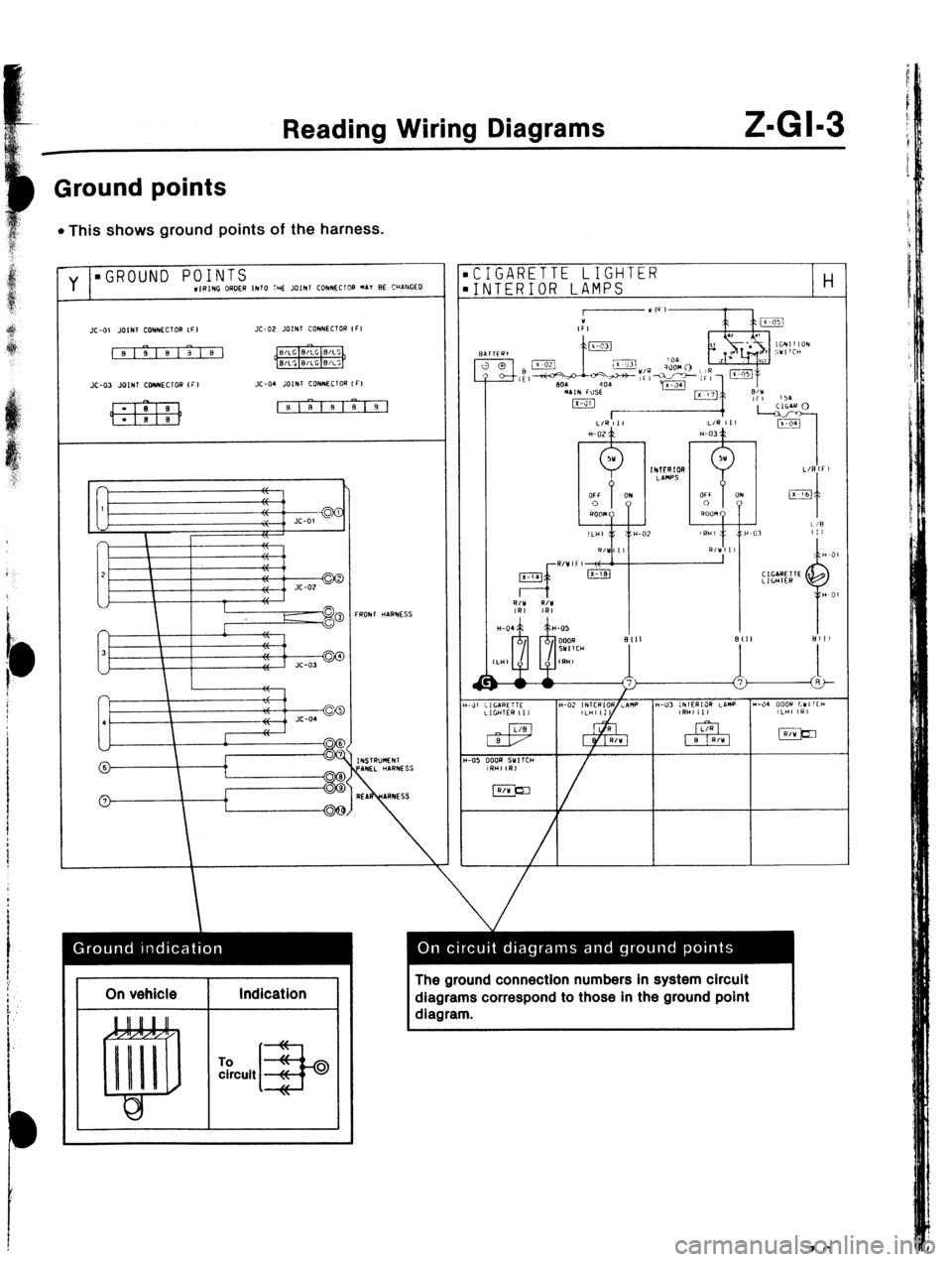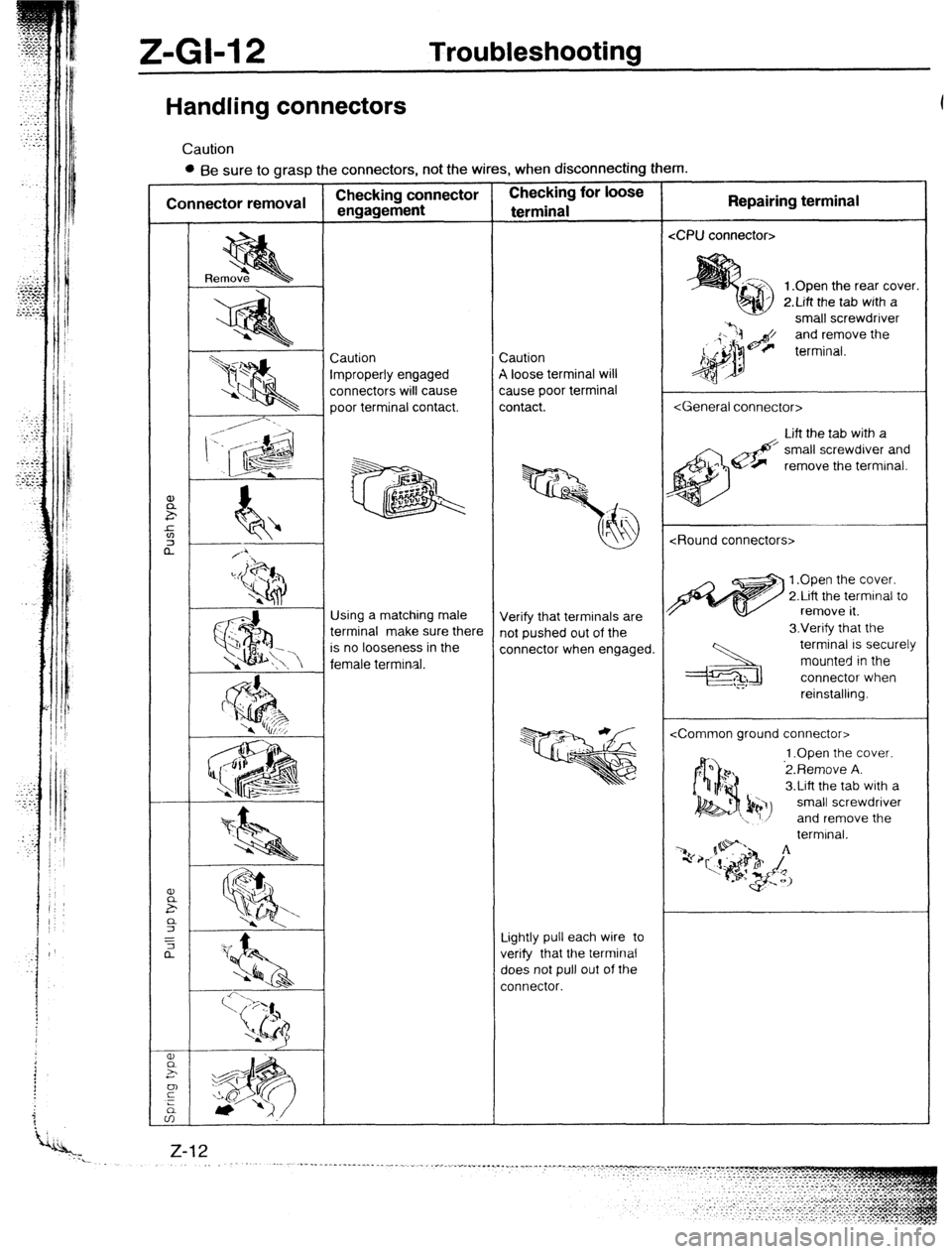Page 1059 of 1164
I
E
,
1
I
i
t
1
I
!
!
I
t:
I.
1.
i
i
Reading Wiring Diagrams Z-Gl-3
Ground points
l This shows ground points of the harness.
CIGARETTE LIGHTER
INTERIOR LAMPS
H
I On vehicle
I Indication
I
To circuit The ground connection numbers in system circuit
diagrams correspond to those in the ground point
diagram.
Page 1060 of 1164
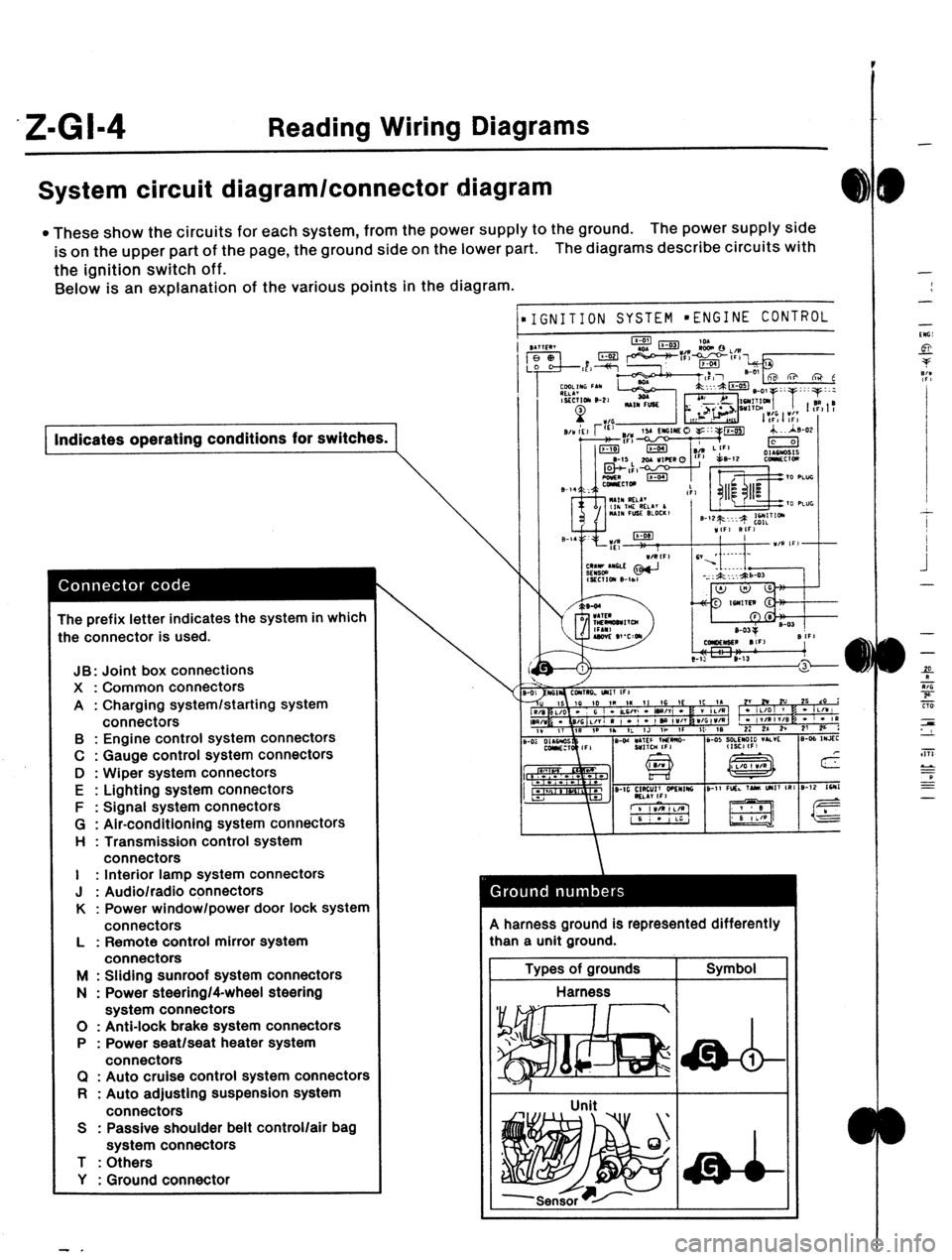
Z-Gl-4 Reading Wiring Diagrams
System circuit diagram/connector diagram
l These show the circuits for each system, from the power supply to the ground. The power supply side
is on the upper part of the page, the ground side on the lower part. The diagrams describe circuits with
the ignition switch off.
Below is an explanation of the various points in the diagram.
) Indicates operating conditions for switches.
The prefix letter indicates the system in which
:he connector is used.
JB: Joint box connections
X : Common connectors
A : Charging system/starting system
connectors
B : Engine control system connectors
C : Gauge control system connectors
D : Wiper system connectors
E : Lighting system connectors
F : Signal system connectors
G : Air-conditioning system connectors
H : Transmission control system
connectors
I : Interior lamp system connectors
J : Audio/radio connectors
K : Power window/power door lock system
connectors
L : Remote control mirror system
connectors
M : Sliding sunroof system connectors
N : Power steering/4-wheel steering
system connectors
0 : Anti-lock brake system connectors
P : Power seat/seat heater system
connectors
Cl : Auto cruise control system connectors
R : Auto adjusting suspension system
connectors
S : Passive shoulder belt control/air bag
system connectors
T : Others
Y : Ground connector
- .
1
\\‘
IGNITION SYSTEM l ENGINE CONTROL 9 harness ground is represented differently
:han a unit ground.
Types of grounds Symbol
Harness
I
-
-
-
-
‘“G:
si-
P
7:’
.I
I
I
.i
-
-
-
f
9
Tiii
zs
LL
Y
a
EE
-
Page 1064 of 1164
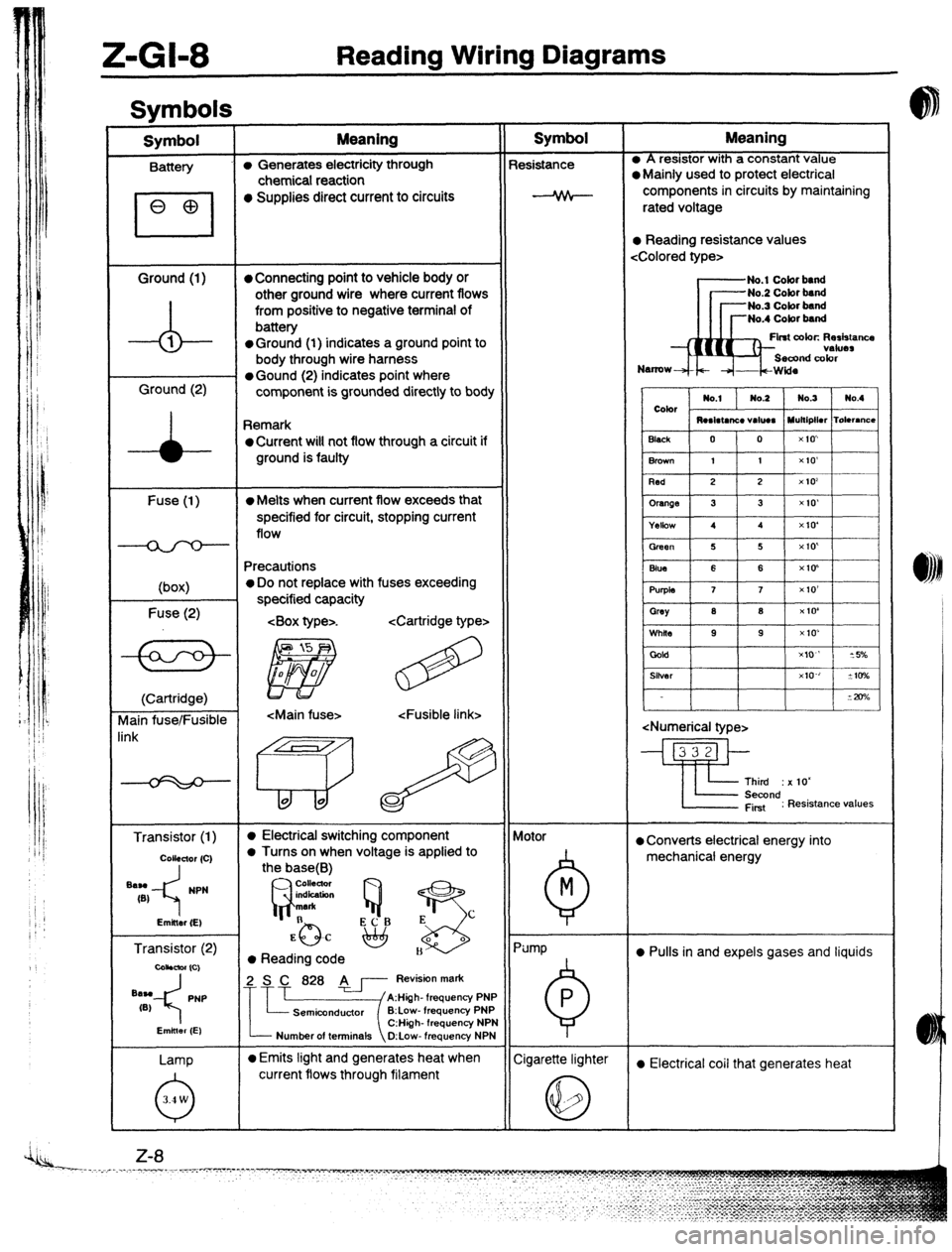
Z-Gl-8 Reading Wiring Diagrams
Svmbols I
Symbol Meaning Symbol Meaning
Battery (I, Generates electricity through Resistance l A resistor with a constant value
chemical reaction l Mainly used to protect electrical
l Supplies direct current to circuits components in circuits by maintaining
rated voltage
l Reading resistance values
Ground (1)
l Connecting point to vehicle body or No.1 Cobr band
-A- other ground wire where current flows -No.2 Cobr band
from positive to negative terminal of -No.3 Cobr band
battery No.4 Cobr band
1
l Ground (1) indicates a ground point to Flnt color. Rerkrancs
body through wire harness
Ground (2) l Gound (2) indicates point where
component is grounded directly to body
Remark
oCurrent wilt not flow through a circuit if
ground is faulty
Fuse (1)
(box)
Fuse (2)
l Melts when current flow exceeds that
specified for circuit, stopping current
flow
Precautions
o Do not replace with fuses exceeding
specified capacity
.
(Cartridge)
vlain fuse/Fusible
Transistor (1)
l Electrical switching component
a Turns on when voltage is applied to Motor
0 Converts electrical energy into
mechanical energy
Transistor (2)
coiibmr (Cl
l Reading code l Pulls in and expels gases and liquids
Lamp
Number of terminals O:Low- frequency NPN
l Emits light and generates heat when
Cigarette lighter
current flows through filament a Electrical coil that generates heat
Page 1065 of 1164
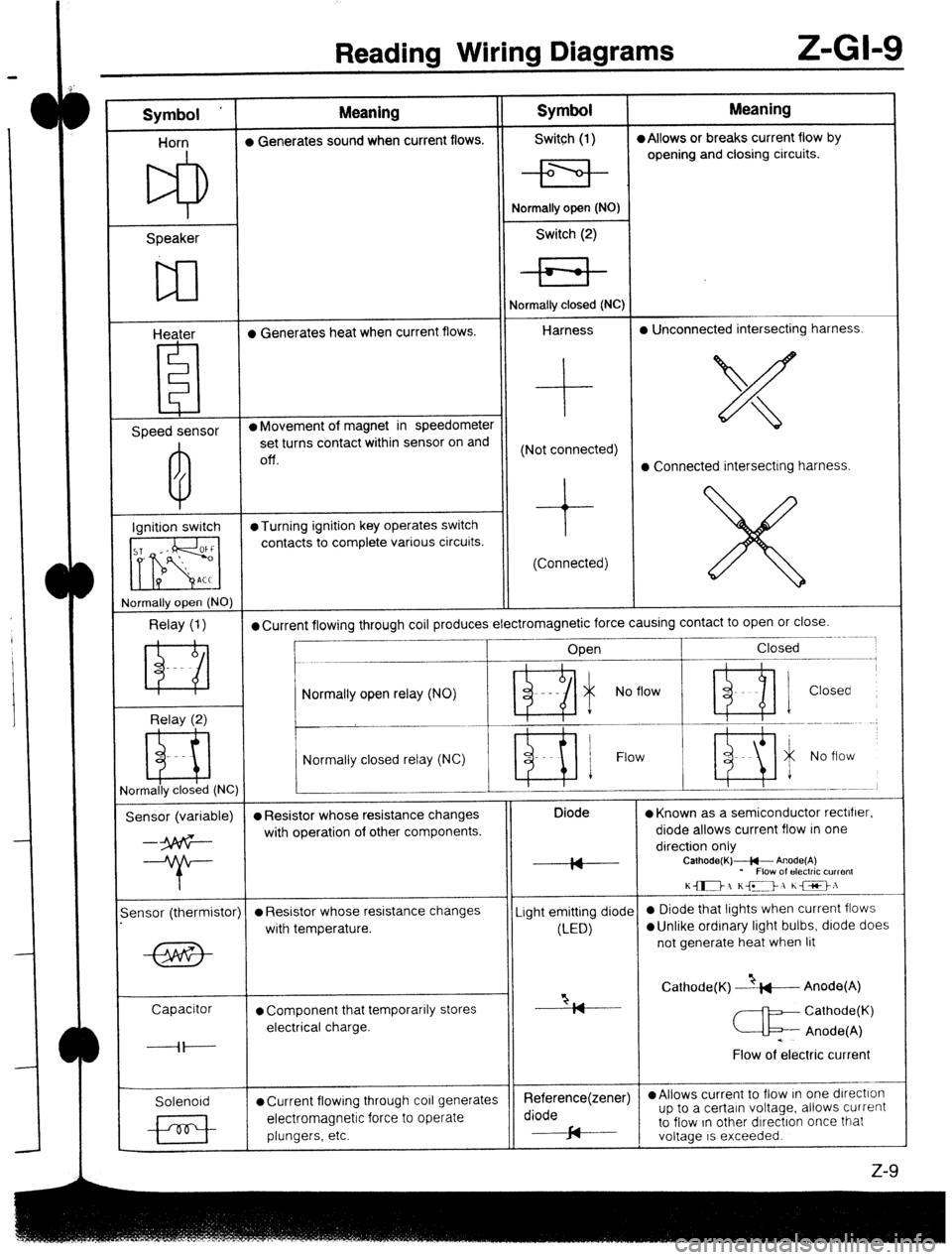
Reading Wiring Diagrams Z-GI-9
Symbol ‘ Meaning Symbol Meaning
Horn l Generates sound when current flows. Switch (1) l Allows or breaks current flow by
opening and closing circuits.
Speaker
w
Heater l Generates heat when current flows. Normally open (NO)
Switch (2)
Normally closed (NC)
Harness l Unconnected intersecting harness.
Speed sensor l Movement of magnet in speedometer
set turns contact within sensor on and
Off. (Not connected)
l Connected intersecting harness.
Ignition switch @Turning ignition key operates switch
contacts to complete various circuits.
(Connected)
rlormally open (NO)
Relay (1) l Current flowing through coil produces electromagnetic force causing contact to open or close.
____- .~.~~
Open Closed
--.--.-m.---------,
Relay (2) Normally open relay (NO)
- Ri i No flow ’ ni 1 Closed
Normally closed relay (NC) Flow
ormally closed (NC)
Sensor (variable) l Resistor whose resistance changes Diode
l Known as a semiconductor rectifier.
--3p6G- with operation of other components. diode allows current flow in one
direction only
--T- IA
IY Calhode(K)+- Anode(A)
* Flow of electric current
K-1 KD, he>:
-
ensor (thermistor)
l Resistor whose resistance changes Light emitting diode 0 Diode that lights when current flows
with temperature.
(LED)
l Unlike ordinary light bulbs, diode does
not generate heat when lit
Capacitor
l Component that temporarily stores “2, Cathode(K) --&---Anode(A)
I7
Cathode(K)
electrical charge.
c Anode(A)
----il---- .
Flow of electric current
Solenoid
l Current flowing through co11 generates Reference(zener) l Allows current to flow In one dlrectlon
electromagnetic force to operate diode up to a certain voltage. allows current
plungers, etc. cd to flow In other dIrectron once that
J-
voltage IS exceeded.
z-9
Page 1068 of 1164
Z-GI-12 Troubleshooting
Handling connectors
Caution
l Be sure to grasp the connectors, not the wires, when disconnecting them.
1 .Open the rear cover.
2.Lift the tab with a
small screwdriver
and remove the
improperly engaged
connectors will cause
poor terminal contact. A loose terminal will
cause poor terminal
Lift the tab with a
remove the terminal.
1 .Open the cover.
2.Lift the terminal to
Using a matching male
is no looseness in the
female terminal. Verify that terminals are
connector when engaged. 3.Verify that the
terminal IS securely
mounted in the
connector when
3.Lift the tab with a
small screwdriver
and remove the
Lightly pull each wire to
verify that the terminal
does not pull out of the
Page 1069 of 1164
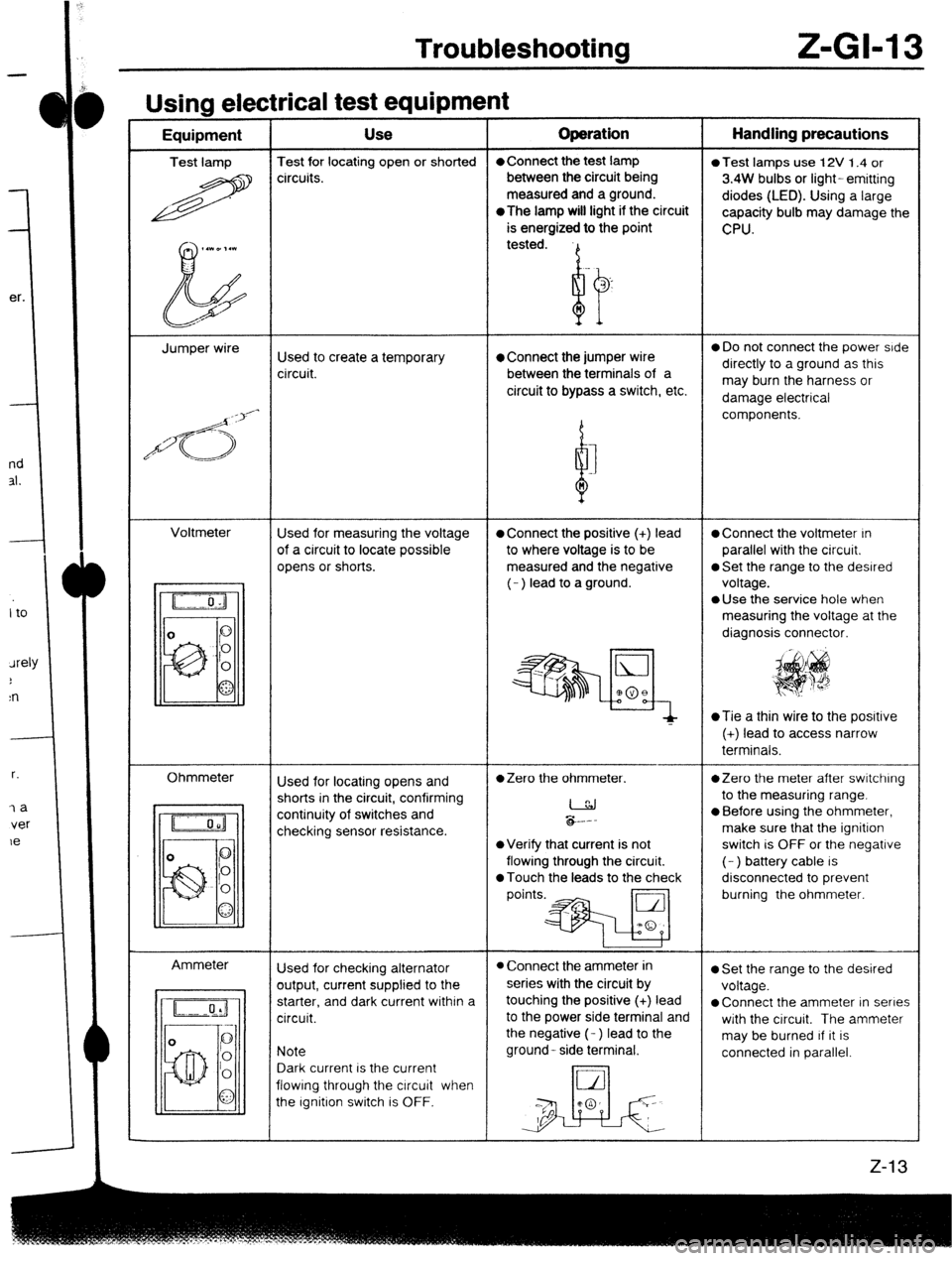
Troubleshooting Z-Gl-13
el
-
Ill
31
-
I1
Jl
:n
r.
7a
ver
le
Usina electrical test eaubment -----w - I - Equipment Use Operation Handling precautions
Test lamp Test for locating open or shorted l Connect the test lamp
0 Test lamps use 12V 1.4 or
R circuits. between the circuit being
3.4W bulbs or light- emitting
measured and a ground.
diodes (LED). Using a large
*The
lamp will light if the circuit
capacity bulb may damage the
is energized to the point
CPU.
,.WD,.l
b tested.
Jumper wire
Used to create a temporary l Connect the jumper wire 0 Do not connect the power side
circuit. between the terminals of a directly to a ground as this
circuit to bypass a switch, etc. may burn the harness or
damage electrical
/d<;>‘-
d components.
I
n
Voltmeter
Used for measuring the voltage
l Connect the positive (+) lead l Connect the voltmeter In
of a circuit to locate possible to where voltage is to be parallel with the circuit.
opens or shorts. measured and the negative
0 Set the range to the desired
(- ) lead to a ground. voltage.
l Use the service hole when
measuring the voltage at the
diagnosis connector.
~Tie a thin wire to the posrtive
(+) lead to access narrow
terminals.
Ohmmeter
Ammeter Used for locating opens and
l Zero the ohmmeter. *Zero the meter after switching
shorts in the circuit, confirming
I to the measuring range.
continuity of switches and
checking sensor resistance. &.--
l Before using the ohmmeter,
make sure that the ignition
l Verify that current is not switch is OFF or the negative
flowing through the circuit. (- ) battery cable is
0 Touch the leads to the check disconnected to prevent
points.* burning the ohmmeter.
Used for checking alternator
l Connect the ammeter in l Set the range to the desired
output, current supplied to the series with the circuit by
voltage.
starter, and dark current within a touching the positive (+) lead
l Connect the ammeter in series
circuit. to the power side terminal and
with the circuit. The ammeter
the negative (- ) lead to the
may be burned If it is
Note ground- side terminal.
connected in parallel.
Dark current is the current
flowing through the circuit when
the Ignition switch is OFF.
Page 1072 of 1164
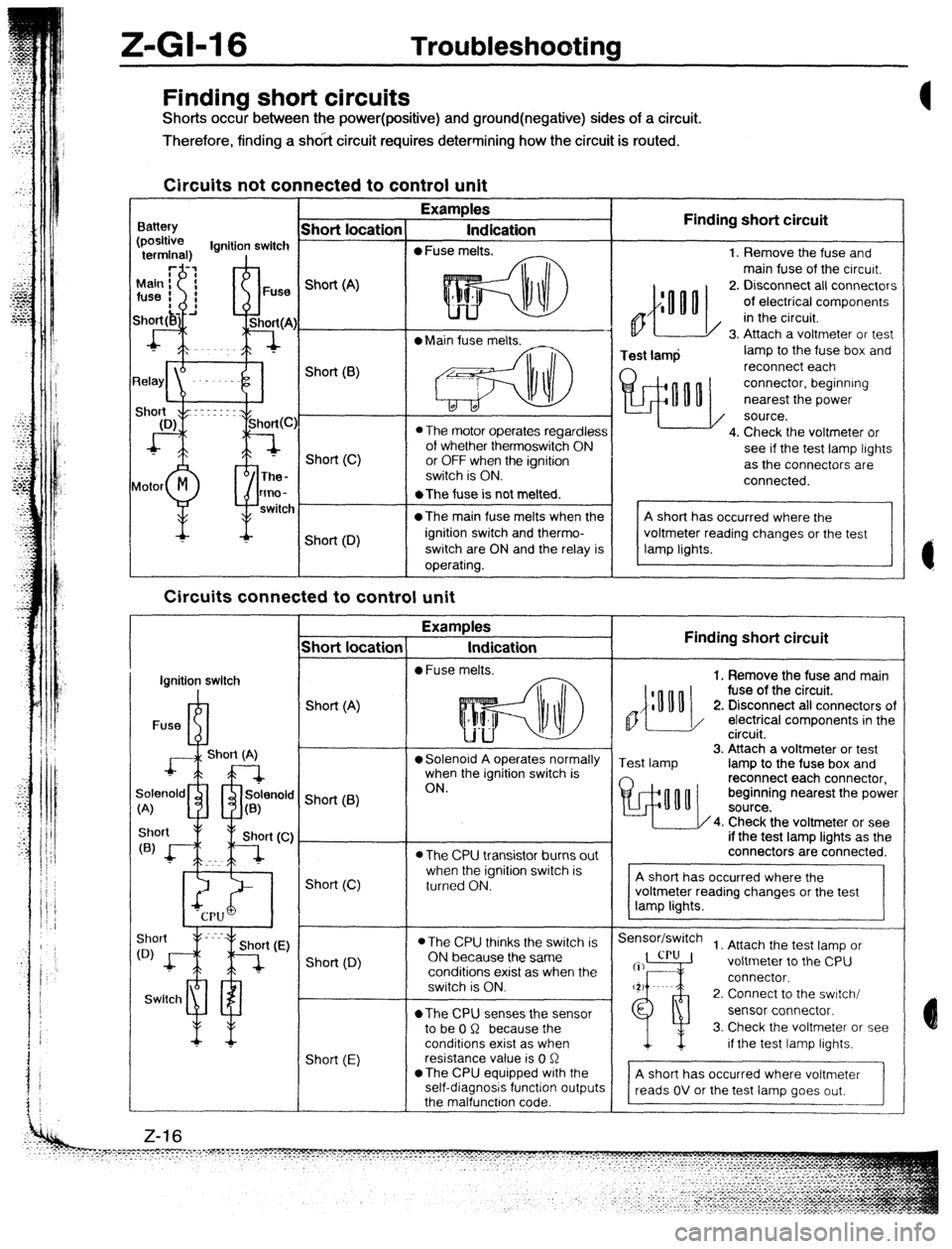
II-GM6 Troubleshooting
Finding short circuits
Shorts occur between the power(positive) and ground(negative) sides of a circuit.
Therefore, finding a shdit circuit requires determining how the circuit is routed.
Circuits not connected to control unit
Examples
Indication
0 Fuse melts. Finding short circuit
0
Test lamp 1. Remove the fuse and
main fuse of the circurt.
2. Disconnect all connectors
of electrical components
in the circuit.
3. Attach a voltmeter or test
lamp to the fuse box and
reconnect each
connector, beginning
nearest the power
source.
4. Check the voltmeter or
see if the test lamp lights
as the connectors are
connected. Finding short circuit
,,{:““o
1. Remove the fuse and main
fuse of the circuit.
2. Disconnect all connectors of
/ electrical components in the
circuit.
Test lamp 3. Attach a voltmeter or test
lamp to the fuse box and
reconnect each connector,
beginning nearest the power
4. Check the voltmeter or see
if the test lamp lights as the
connectors are connected.
Sensor/switch
1. Attach the test lamp or
voltmeter to the CPU
connector.
2. Connect to the swrtch/
sensor connector.
3. Check the voltmeter or see
if the test lamp lights.
A short has occurred where voltmeter
reads OV or the test lamp goes out,
- Short location
Battery Short (A)
l Main fuse melts.
L* Short(B)
0 The motor operates regardless
of whether thermoswitch ON
or OFF when the ignition
switch is ON. Short (C)
lotor
M
P The-
tmo-
switc *The fuse is not melted.
@The main fuse melts when the
ignition switch and thermo-
switch are ON and the relay is
operating. Short (D)
Circuits connected to control unit
-T Examples
Indication
l Fuse melts.
- Short locatior
I
ignition switch
I
Fuse R-l Short (A)
J+L--l
Short (A) l Solenoid A operates normally
when the ignition switch is
ON.
9enold m rfr solenok
;<
A) u a(B) ’ Short (6)
l The CPU transistor burns out
when the ignition switch is
turned ON. Short (C)
l The CPU thinks the switch is
ON because the same
conditions exist as when the
switch is ON.
*The CPU senses the sensor
to be 0 R because the
conditions exist as when
resistance value is 0 R
*The CPU equipped with the
self-diagnosis function output
the malfunctron code. Short (0)
Swltcl1 ml
Short (E) Z-16
Page 1077 of 1164
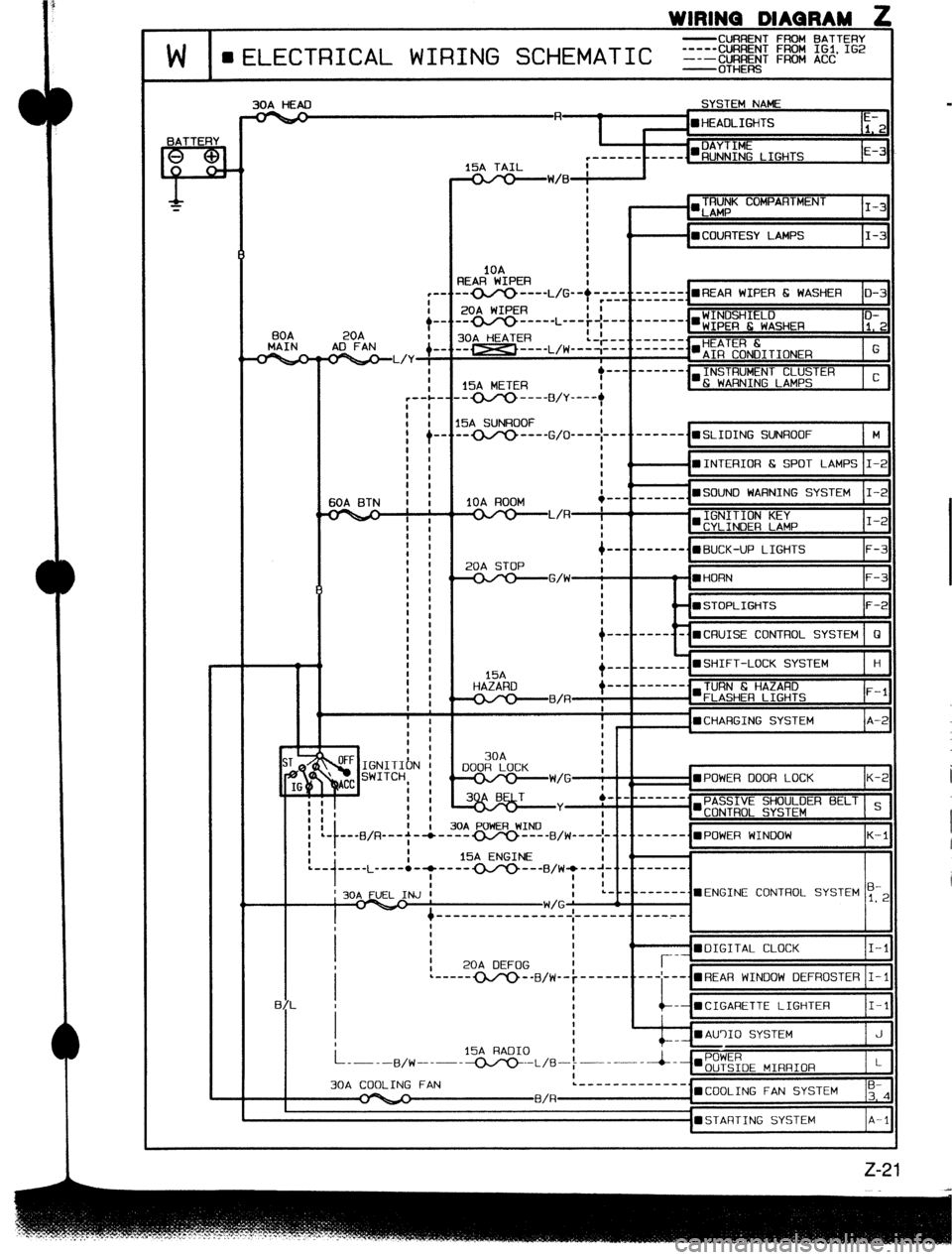
WIRINQ DIAQRAM 2
-CURRENT FROM BATTERY
W II f”‘l FCTRICAL WIRING SCHEMATIC _1_=;!:: %% :% I’*
BATTERY
P-
f
30A HEAD SYSTEM NAME
-a
c------
15A TAIL I
t-
BOA
MAIN
7 ST /;
(i
IG
:
:
1
:
I
20A ?--
AD FAN
_-. --
VW/B : I
I
I
I TRUNK COMPARTMENT
l LAMP I-3
:
I ( - n COURTESY LAMPS I-3
I
1OA
3EAR WIPER I
-- ---- L,G--/-~~-.=/zzI~~~
l REAR WIPER 6 WASHER D-3
20A WIPER
30A HEATER
,-w ---- L,w-l;c::::
I
INSTRUMENT CLUSTER
l & WARNING LAMPS C
15A METER
-----+yy _---
IOA ROOM
-1
t
----------.mBUCK-UP LIGHTS F-3
20A STOP
-G/W i - m HORN F-3
1
I
F-2
/--------%CRUISE CONTROL SYSTEM 0
. l SHIFT-LOCK SYSTEM
15A
HAZARD
I-- ------. H
--- _------
TURN 6 HAZARD
--o----B/R ; n FLASHER LIGHTS F-l
I
IPOWER DOOR LOCK K-;
’ PASSIVE SHOULDER BELT s
-mCONTROL SYSTEM
+-B/R--+-/ “Yr. I YV.LI, T.AI1a.A
---------B/W----~-i-t------. n P,-&,ER WINDOW
K-l
I
1
I I 15A ENGINE
- - I
:-,-..-L ----.- T -------- B,wl--‘-
; 30A FUEL INJ ’ a...
I- W/G ’ --------.=ENGINE CONTROL SYSTEM y-2
t ----------e--e-_ I--- ---_ .w-.w-.m-.
I
I t
: I 0
WDIGITAL CLOCK I-l
,
I 20A DEFOG I r-- WINDOW DEFROSTER 1-1
B/L I -- mCIGARETTE LIGHTER I-l
:
_ mAU’)IO SYSTEM
i----a,w-.--15A RAo1o -.-L,e-i~---i--mPOWER J
OUTSIDE MIRRIOR L
30A COOLING FAN L- ------------.
l COOLING FAN SYSTEM ;-4
B/R-p-
l STARTING SYSTEM A-l
